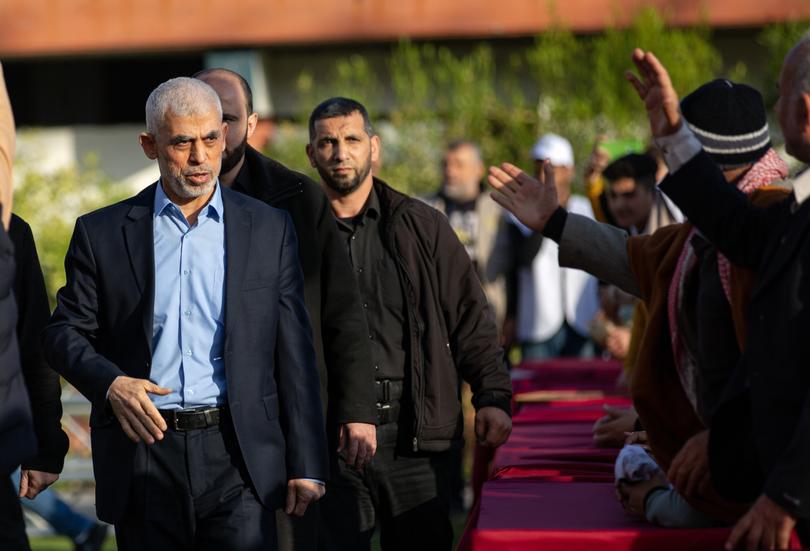THE NEW YORK TIMES: Hamas documents show tunnel battle strategy

TEL AVIV, Israel — Hamas’ handbook for underground combat describes, in meticulous detail, how to navigate in darkness, move stealthily beneath the Gaza Strip and fire automatic weapons in confined spaces for maximum lethality.
Battlefield commanders were even instructed to time, down to the second, how long it took their fighters to move between various points underground.
The 2019 manual, which was seized by Israeli forces and reviewed by The New York Times, was part of a yearslong effort by Hamas, well before its Oct. 7 attack and current war with Israel, to build an underground military operation that could withstand prolonged attacks and slow down Israeli ground forces inside the darkened tunnels.
Sign up to The Nightly's newsletters.
Get the first look at the digital newspaper, curated daily stories and breaking headlines delivered to your inbox.
By continuing you agree to our Terms and Privacy Policy.Just a year before attacking Israel, Yahya Sinwar, the leader of Hamas in the Gaza Strip, approved spending $225,000 to install blast doors to protect the militia’s tunnel network from airstrikes and ground assaults.
The approval document said Hamas brigade commanders had reviewed the tunnels below Gaza and identified critical places underground and at the surface that needed fortification.
The records, along with interviews with experts and Israeli commanders, help explain why, nearly a year into the war, Israel has struggled to achieve its objective of dismantling Hamas.
Israeli officials spent years searching for and dismantling tunnels that Hamas could use to sneak into Israel to launch an attack. But assessing the underground network inside Gaza was not a priority, a senior Israeli official said, because an invasion and full-scale war there seemed unlikely.

All the while, officials now realise, Hamas was girding for just such a confrontation.
Were it not for the tunnels, experts say, Hamas would have stood little chance against the far superior Israeli military.
The underground combat manual contains instructions on how to camouflage tunnel entrances, locate them with compasses or GPS, enter quickly and move efficiently.
“While moving in the dark inside the tunnel, the fighter needs night-vision goggles equipped with infrared,” the document, written in Arabic, reads. Weapons should be set to automatic and fired from the shoulder. “This type of shooting is effective because the tunnel is narrow, so the shots are aimed at the kill zones in the upper part of the human body.”
Israeli officials knew before the war that Hamas had an extensive tunnel network, but it has proved to be more sophisticated and extensive than they realized. Early in the war, they estimated that it stretched for about 250 miles. Now they believe it is up to twice as long.
And they continue to discover new tunnels. Just last week, Israeli commandos rescued a Bedouin Arab citizen of Israel who was found alone in an underground warren. The government said Sunday that six hostages had been found dead in another tunnel.
Sinwar, Israel’s highest-value target, has been suspected of managing the war and evading capture from a tunnel.
The records show how both sides have had to adapt their tactics in the war. Just as Israel underestimated the tunnels, Hamas prepared for subterranean battles that have not materialized. Israel was reluctant, especially early in the war, to send troops underground where they might face combat. Hamas has primarily ambushed soldiers near tunnel entrances while avoiding direct confrontations.
That has left Hamas to use the tunnels to launch aboveground hit-and-run attacks, hide from Israeli forces and detonate explosives using remote triggers and hidden cameras, according to Israeli military officials and a review of battlefield photos and videos.
These maneuvers have slowed Israel’s assault, but its military has still decimated Hamas’ ranks, routed them from strongholds and forced them to abandon huge swaths of the tunnel network that they invested so heavily to build.
Members of the Israeli military discovered the tunnel warfare document in Gaza City’s Zeitoun district in November, officials said. A letter from Sinwar to a military commander was found that same month south of the city. The documents were made available to the Times by Israeli military officials.
A military spokesperson said that “the fact that Hamas is hiding in tunnels and managing much of the fighting from there prolongs the war.” A senior Hamas official declined to comment on the tunnel strategy.
The markings on the documents are consistent with other Hamas materials that have been made public or been examined by the Times. And Israeli soldiers have described details, such as camouflaged tunnel entrances and recently installed blast doors, that are consistent with the Hamas documents. The documents also describe the use of gas detectors and night-vision goggles, equipment that Israeli forces have found inside tunnels.
“Hamas’ combat strategy is based on underground tactics,” said Tamir Hayman, a former head of Israel’s military intelligence. “This is one of the primary reasons they have managed to withstand the IDF thus far,” he continued, using an abbreviation for the Israeli military.
Since the war started, much has been revealed about the subterranean network, which has been called the “Gaza Metro.” Hamas uses some rudimentary tunnels simply to mount attacks. The fighting manual describes how people should maneuver these narrow passages in darkness: with one hand on the wall and the other on the fighter in front.
Other tunnels are sophisticated command-and-control centres or arteries connecting underground weapons factories to storage facilities — concealing Hamas’ entire military infrastructure. In some cases, Hamas has used solar panels installed on the roofs of private homes to provide power underground.
Some tunnels also serve as communication hubs. This past winter, Israeli forces discovered a Nokia telecommunications system underneath the headquarters of the U.N. agency for Palestinian refugees.
Such Nokia systems provide voice and data services, according to the manual obtained by the Times, and could have functioned as a switchboard for an underground communication network. But the features require additional hardware and it is not clear what abilities Hamas had.
Hamas has been known to hold Israeli hostages underground, so every tunnel needs to be investigated and cleared, Israeli officials say.
Destroying a tunnel section can take dozens of soldiers about 10 hours, according to a senior Israeli officer who is an expert on tunnel warfare. Last year, the Israeli army discovered a tunnel that had a depth of 250 feet — about the height of a 25-story building. The army said it took months to destroy it.
“I cannot overstate that in any way. The tunnels impact the pace of the operations,” said Daphné Richemond-Barak, a tunnel warfare expert at Reichman University in Israel. “You can’t advance. You can’t secure the terrain.”
“You’re dealing with two wars,” she added. “One on the surface and one on the subsurface.”
One Israeli special operations officer, who, like others, spoke on the condition of anonymity because they were not authorized to publicly discuss military activities, said that as soldiers approached the tunnels, Hamas sometimes blasted the ceilings, causing cave-ins that would block the path.
An Israeli military official said it could take years to destroy the entire tunnel network.
Israel’s military leadership has made the tunnels its main target. But the campaign has come at a steep cost for Palestinian civilians. Many of the tunnels snake beneath densely occupied areas. Israel has publicized videos of the military destroying tunnels with more than 16 tons of explosives per kilometre.
The Israeli military estimates that it costs Hamas about $300,000 to build roughly a half-mile-long rudimentary tunnel. Richemond-Barak said that the letter from Sinwar highlighted the expense and sophistication behind the effort.
The letter was written to Mohammed Deif, the group’s military commander, who is believed to have been an architect of the Oct. 7 attack. It is not clear when Hamas completed its review of tunnel fortifications or whether it was done in connection to the attack planning. Sinwar wrote that “the brigades will be given the money according to the level of importance and necessity.”
The letter could indicate where the group anticipated the toughest fighting. Sinwar authorized the most money for doors in northern Gaza and Khan Younis. Indeed, some of the heaviest fighting during the war has taken place in those areas.
“The Hamas tunnel system was an essential, if not existential element of their original battle plan,” said Ralph F. Goff, a former senior CIA official who served in the Middle East.
This article originally appeared in The New York Times.
© 2024 The New York Times Company
Originally published on The New York Times
